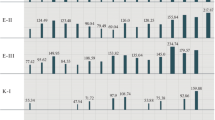Abstract
A semi-natural Drosophila melanogaster population was twice forced through a genetic bottleneck and allowed to recover naturally. In one case additional variation was introduced to the recovering population. The percentage of lethal chromosomes, the level of allelism between these lethals, and the effective population size calculated from the allelism of these lethals all rose sharply in the few generations following each bottleneck, though this was not the case in the very first generation. Thereafter this rise decelerated rapidly and never returned to pre-bottleneck levels. Additional introduced variation had little effect. The reasons for and implications of this pattern have been considered.
Similar content being viewed by others
References
Anderson, W. W., 1969. Genetics of natural populations. XLI. The selection coefficients of heterozygotes for lethal chromosomes in Drosophila on different genetic backgrounds. Genetics 62: 827–836.
Begon, M., 1977. The effective size of a natural Drosophila subobscura population. Heredity 38: 13–18.
Begon, M., Chadburn, R. & Bishop, J. A., 1984a. The effects of different levels of genetic variation on the population ecology of a semi-natural Drosophila population. In preparation.
Begon, M., Chadburn, R., Bishop, J. A. & Keill, C., 1984b. Genetic structure of a semi-natural Drosophila melanogaster population after a bottleneck: the relative fitnesses of second chromosomes. Genetica (in press).
Begon, M., Krimbas, C. B. & Loukas, M., 1980. The genetics of Drosophila subobscura populations. XV. Effective size of a natural population estimated by three independent methods. Heredity 45: 335–350.
David, F. N. & Johnson, N. L., 1952. The truncated Poisson. Biometrics 8: 275–285.
Dobzhansky, Th., 1946. Genetics of natural populations. XIII. Recombination and variability in populations of Drosophila pseudoobscura. Genetics 31: 269–290.
Dobzhansky, Th., Levene, H., Spassky, B. & Spassky, N., 1959. Release of genetic variability through recombination. III. Drosophila prosaltans. Genetics 44: 75–92.
Dobzhansky, Th. & Spassky, B., 1968. Genetics of natural populations. XL. Heterotic and deleterious effects of recessive lethals in populations of Drosophila pseudoobscura. Genetics 59: 411–425.
Dobzhansky, Th. & Wright, S., 1941. Genetics of natural populations. V. Relations between mutation rate and accumulation of lethals in populations of Drosophila pseudoobscura. Genetics 26: 23–51.
Greenwood, J. J. D., 1974. Effective population numbers in the snail Cepaea nemoralis. Evolution 28: 513–526.
Karlik, A. & Feuerbach-Mravlag, H., 1977. The genetic conditions in heterozygous and homozygous populations of Drosophila. III. EMS induced lethal mutations in homo- and heterozygous populations of Drosophila melanogaster. Genetica 47: 87–92.
Loukas, M., Krimbas, C. B. & Sourdis, J., 1980. The genetics of Drosophila subobscura populations. XIII. A study of lethal allelism. Genetica 54: 197–207.
Prout, T., 1954. Genetic drift in irradiated experimental populations of Drosophila melanogaster. Genetics 39: 529–545.
Spassky, B., Spassky, N., Levene, H. & Dobzhansky, Th., 1958. Release of genetic variability through recombination. I. Drosophila pseudoobscura. Genetics 43: 844–867.
Sperlich, D. & Karlik, A., 1970. The genetic conditions in heterozygous and homozygous populations of Drosophila. I. The fate of alien chromosomes. Genetica 41: 265–304.
Sperlich, D. & Karlik, A., 1972. The genetic conditions in heterozygous and homozygous populations of Drosophila. II. X-ray induced lethals in a homozygous and a heterozygous population. Genetica 43: 443–452.
Spiess, E. B., 1959. Release of genetic variability through recombination. II. Drosophila persimilis. Genetics 44: 43–58.
Spiess, E. B. & Allen, A. C., 1961. Release of genetic variability through recombination. VII. Second and third chromosomes of Drosophila melanogaster. Genetics 46: 1531–1553.
Sved, J. A. & Ayala, F. J., 1970. A population cage test for heterosis in Drosophila pseudoobscura. Genetics 66: 97–113.
Wallace, B., 1951. Genetic changes within populations after X-irradiation. Genetics 36: 612–628.
Wallace, B., 1956. Studies on irradiated populations of Drosophila melanogaster. J. Genetics 54: 280–293.
Wright, S., 1931. Evolution in Mendelian populations. Genetics 16: 97–159.
Wright, S., 1938. Size of population and breeding structure in relation to evolution. Science 87: 430–431.
Wright, S., Dobzhansky, Th. & Hovanitz, W., 1942. Genetics of natural populations. VII. The allelism of lethals in the third chromosome of Drosophila pseudoobscura. Genetics 27: 363–394.
Author information
Authors and Affiliations
Rights and permissions
About this article
Cite this article
Begon, M., Chadburn, R., Bishop, J.A. et al. Genetic variation in a semi-natural Drosophila population after a bottleneck I. Lethals, their allelism and effective population size. Genetica 66, 11–20 (1985). https://doi.org/10.1007/BF00123601
Received:
Accepted:
Issue Date:
DOI: https://doi.org/10.1007/BF00123601




